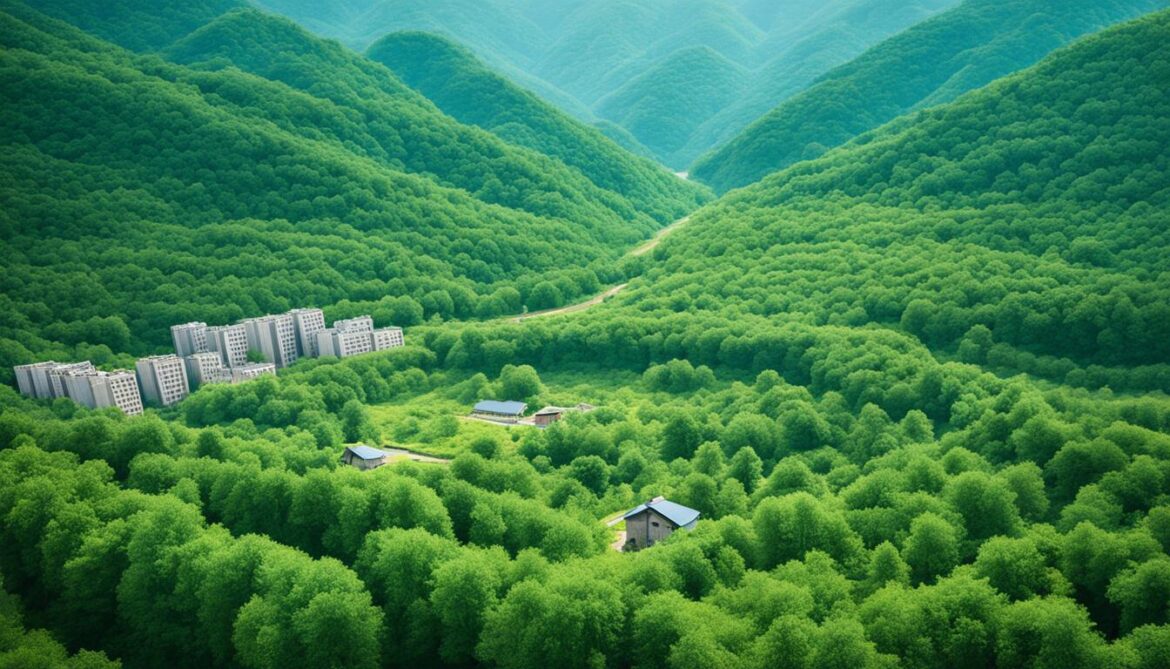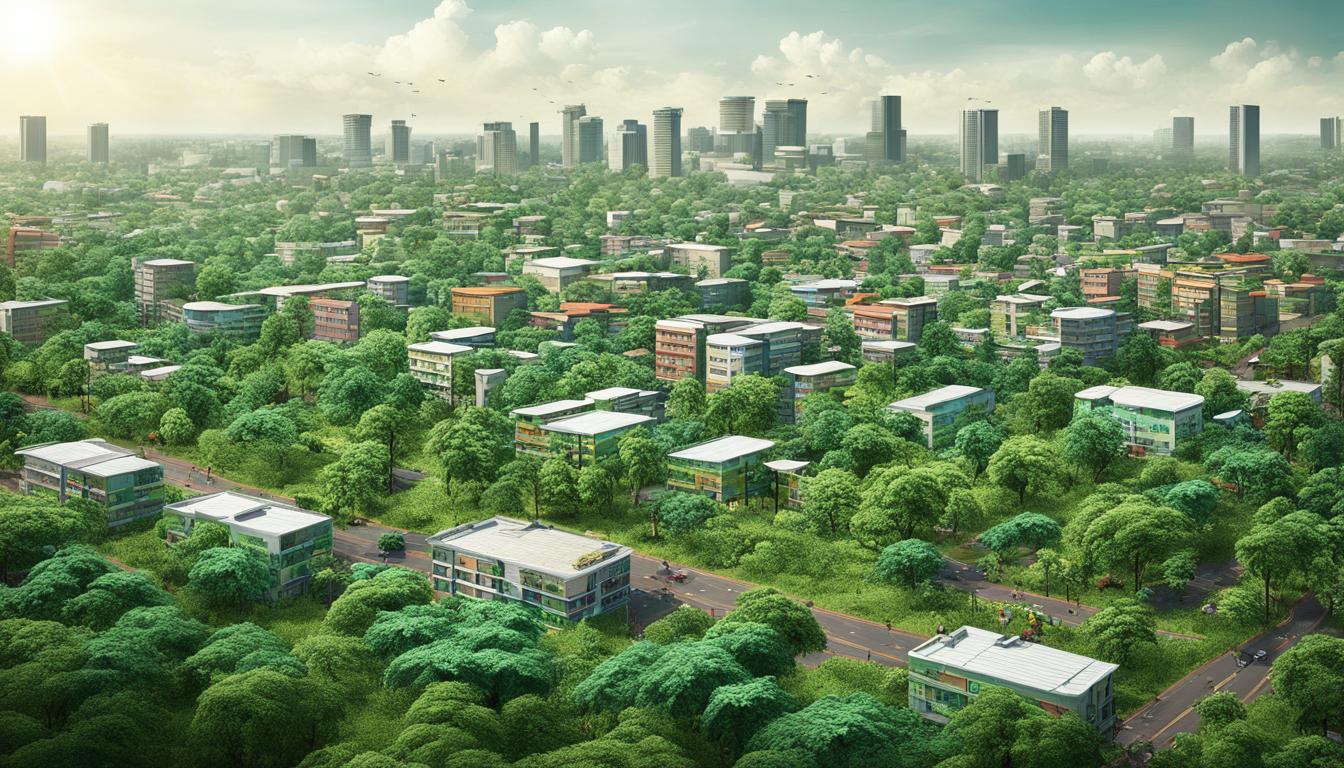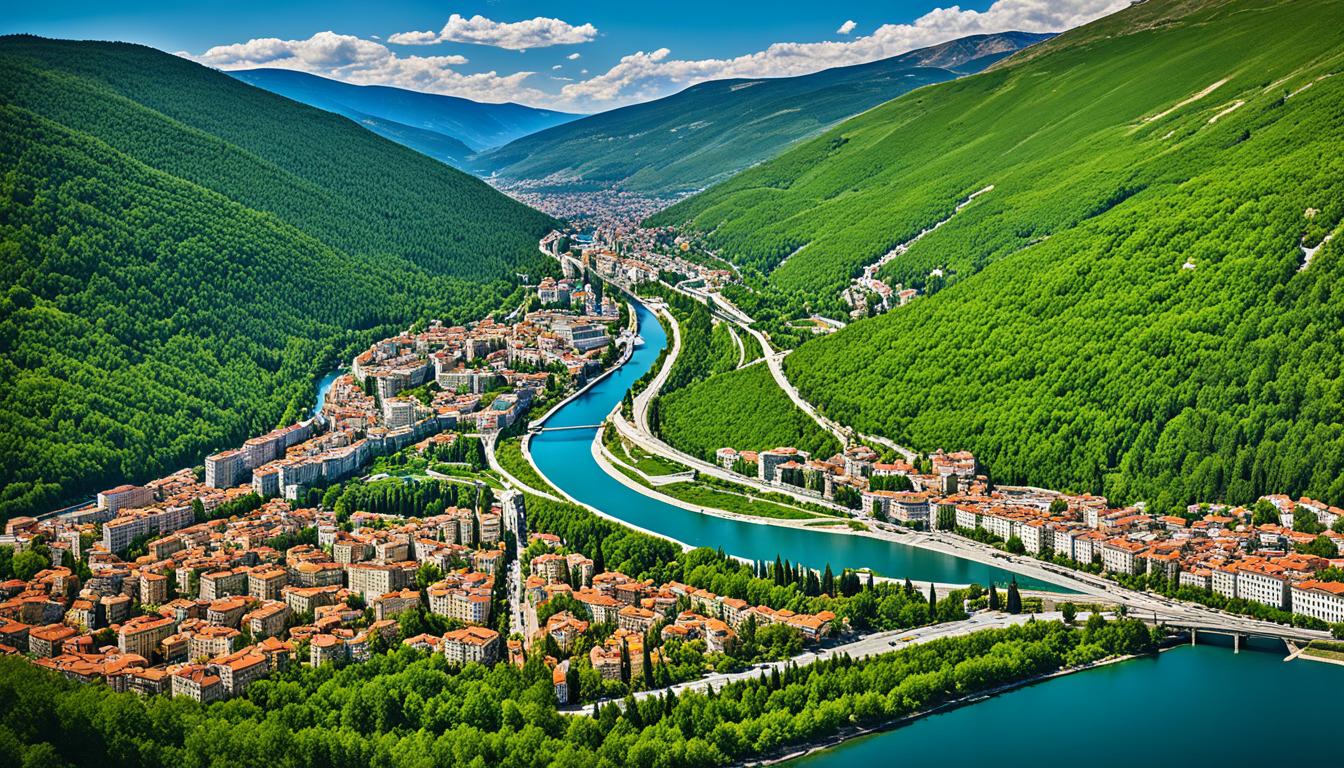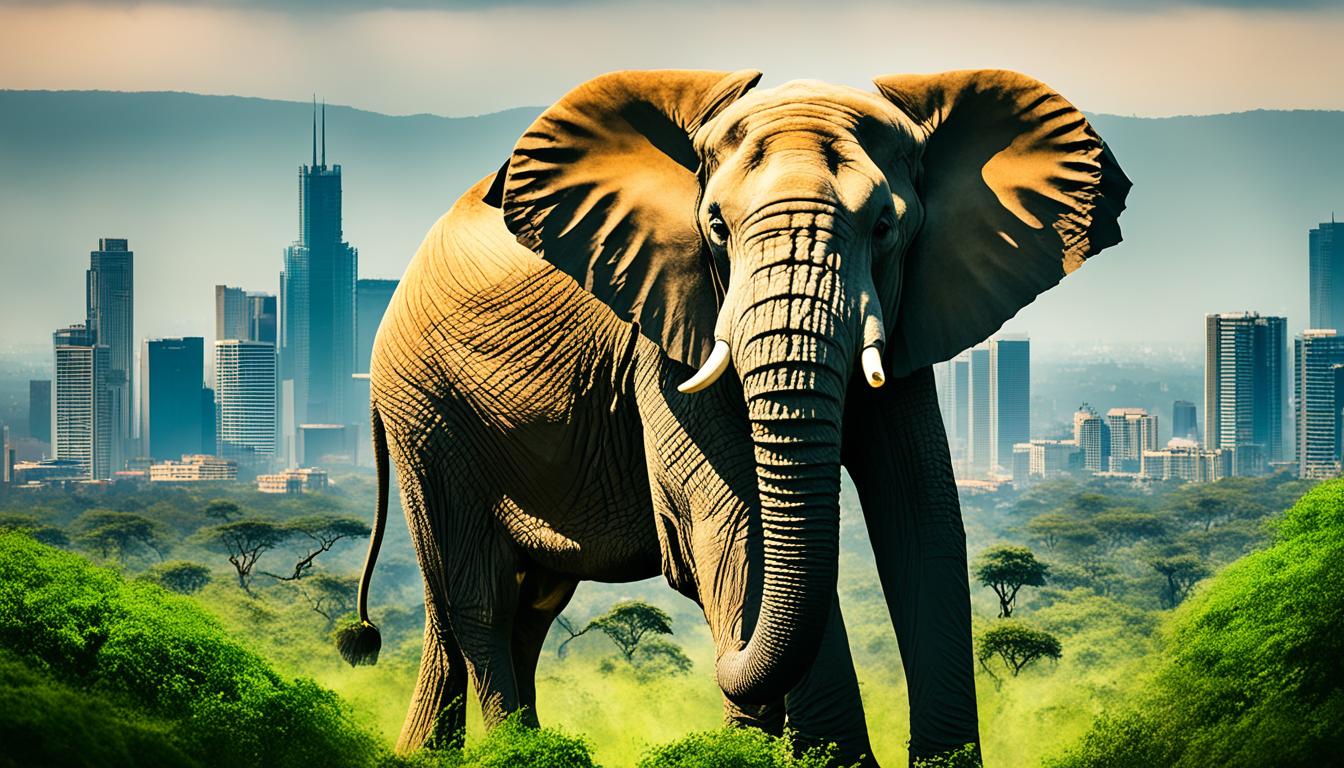North Korea Biodiversity and the Built Environment
Did you know that North Korea is home to diverse animal and plant species, making it a biodiversity hotspot? The delicate balance of ecosystems in this region is essential for the survival of numerous species and the overall health of the environment.
Conservation efforts are crucial to protect North Korean wildlife and mitigate the negative impacts of urban development on biodiversity. As the country grapples with environmental challenges, such as habitat loss and climate change, awareness and sustainable practices become even more vital.
Key Takeaways:
- North Korea is a biodiversity hotspot with diverse animal and plant species.
- Conservation efforts are needed to protect North Korean wildlife.
- Urban development poses challenges to biodiversity conservation.
- Environmental sustainability and green infrastructure initiatives are important for preserving North Korea’s biodiversity.
- International cooperation plays a significant role in the conservation of North Korean biodiversity.
The Demilitarized Zone (DMZ): A Haven for Nature in North Korea
The demilitarized zone (DMZ) that stretches along the border between North and South Korea has become a haven for nature. Spanning approximately 248 kilometers long and 4 kilometers wide, the DMZ acts as a buffer zone, separating the two countries. This unique and restricted area is home to a diverse range of North Korean wildlife and houses many species that are rarely found in other parts of the Korean Peninsula.
Within the DMZ, visitors can encounter rare animal species such as Asiatic black bears, red-crowned cranes, musk deer, and otters. These unique species thrive in the untouched habitats and abundant resources provided by the demilitarized zone. The conservation efforts within the DMZ are crucial in protecting these unique species and ensuring their long-term survival.
Wildlife surveys and the use of remote cameras play a vital role in monitoring the biodiversity and behavior of the rare species that inhabit the DMZ. These techniques help researchers gain valuable insights into the population dynamics, breeding patterns, and ecological relationships of the wildlife within the zone.
Habitat protection is a key focus of conservation efforts in the DMZ. The preservation and restoration of the natural habitats within the area are vital to maintaining the delicate balance of the ecosystem. By protecting these habitats and ensuring their sustainability, conservationists aim to safeguard the diverse array of flora and fauna that call the DMZ their home.
In conclusion, the demilitarized zone (DMZ) serves as a remarkable sanctuary, where North Korean wildlife thrives amidst political tensions. The unique combination of protected habitats, conservation efforts, and scientific research within the DMZ contributes to the preservation of North Korea’s precious biodiversity. Efforts to protect and restore the DMZ’s natural treasures not only benefit the wildlife within its borders but also hold the promise of a sustainable future for North Korea’s remarkable natural heritage.
Kumgang Mountain: A Diverse Ecosystem in North Korea
Kumgang Mountain in North Korea is a haven of biodiversity, boasting a rich and diverse ecosystem that is spread across its majestic peaks and valleys. The mountain is home to a remarkable array of plant and animal species, making it a vital hotspot for North Korean biodiversity.
The conservation of Kumgang Mountain’s unique ecosystem is of utmost importance to ensure the survival and well-being of its diverse inhabitants. North Korea has implemented various forest restoration and conservation measures to protect and restore the mountain’s delicate ecosystems.
“Kumgang Mountain is a treasure trove of natural wonders, with its lush forests and vibrant wildlife. It is our responsibility to preserve and safeguard this precious landscape for future generations.” – Conservation Official
Tree planting programs have been initiated to replenish the mountain’s forests, which serve as essential habitats for a wide range of species. The restoration of these forests not only helps in preserving the biodiversity but also contributes to the overall health and stability of the ecosystem.
In addition to domestic initiatives, North Korea actively collaborates with international organizations and participates in environmental projects to promote biodiversity conservation in Kumgang Mountain. This international collaboration plays a crucial role in sharing knowledge, resources, and expertise, ultimately enhancing the effectiveness of conservation efforts.
The Benefits of Forest Restoration and Conservation
The restoration of Kumgang Mountain’s forests and the conservation of its diverse ecosystem yield numerous benefits, both for the environment and for humanity as a whole.
- Preservation of Biodiversity: Protecting the rich biodiversity of Kumgang Mountain ensures the survival of rare and endangered species, safeguarding their ecological roles and genetic diversity.
- Ecosystem Services: The mountain’s diverse ecosystem provides vital ecosystem services such as water purification, soil stability, and carbon sequestration, benefiting both the region and the planet as a whole.
- Economic Opportunities: The conservation of Kumgang Mountain’s natural beauty and unique biodiversity creates opportunities for eco-tourism and sustainable development, contributing to the local economy.
Overall, the conservation of Kumgang Mountain’s diverse ecosystem through forest restoration and international collaboration is essential for the preservation of North Korean biodiversity and the sustainable development of the region.

The State of Biodiversity in North Korea
The state of biodiversity in North Korea raises concerns as a significant number of species are endangered or facing decline. The 5th National Report on Biodiversity of DPR Korea emphasizes the importance of conservation efforts in safeguarding the unique flora and fauna of the country. Environmental challenges such as pollution, deforestation, and climate change pose significant threats to North Korea’s biodiversity. In response to these challenges, efforts are being made to address them and raise awareness about the importance of biodiversity conservation.
To combat the decline in North Korean biodiversity, various conservation measures have been implemented. These efforts include the establishment of protected areas, wildlife conservation programs, and public education initiatives. Additionally, international collaborations play a crucial role in sharing expertise, resources, and knowledge to support biodiversity conservation in North Korea.
The 5th National Report on Biodiversity of DPR Korea revealed key findings about the current state of North Korean biodiversity:
- Endangered Species: A significant percentage of species in North Korea are classified as endangered. This includes iconic species such as the Amur Leopard, Asiatic Black Bear, Red-crowned Crane, Korean Pine, and Korean Tiger.
- Habitat Destruction: Deforestation, driven by logging and agricultural expansion, is a primary factor contributing to habitat loss and endangerment of species.
- Climate Change Impacts: Rising temperatures, changing precipitation patterns, and extreme weather events pose challenges to North Korea’s biodiversity by disrupting ecosystems and affecting species’ habitats.
- Pollution: Industrial pollution and improper waste management practices affect air and water quality, harming wildlife and natural habitats.
Biodiversity conservation efforts in North Korea involve a multi-faceted approach that combines habitat restoration, species protection, and sustainable practices. Conservation organizations, researchers, and government agencies collaborate to implement strategies for preserving North Korean biodiversity.
“Protecting North Korea’s biodiversity is crucial for the long-term sustainability of ecosystems and the overall well-being of the country. Conservation efforts must address the environmental challenges we face, including pollution, deforestation, and climate change.”

| Environmental Challenges | Impact on Biodiversity |
|---|---|
| Pollution | Disrupts ecosystems, harms wildlife, and degrades habitats |
| Deforestation | Causes habitat loss and endangers species |
| Climate Change | Alters ecosystems, affects species’ habitats and distribution |
Endangered Species in North Korea
North Korea is home to several endangered species, including the Amur Leopard, Asiatic Black Bear, Red-crowned Crane, Korean Pine, and Korean Tiger. These species face various threats, such as habitat loss and poaching, which put them at risk of extinction. Conservation efforts in North Korea are focused on preserving the habitats of these endangered species and raising awareness about their importance for the country’s biodiversity.
The Amur Leopard is one of the rarest big cats in the world, with less than 100 individuals remaining in the wild. It is found in the remote mountainous regions of North Korea, facing threats from habitat destruction and illegal wildlife trade.
The Asiatic Black Bear, also known as the Moon Bear, is a critically endangered species in North Korea. It is hunted for its body parts, which are used in traditional medicine, and its habitat is fragmented due to deforestation and agricultural expansion.
The Red-crowned Crane is a symbolic bird in Korean culture and is also classified as endangered. Its wetland habitats are being destroyed or degraded, leading to a decline in its population. Conservation efforts are underway to protect and restore these vital habitats.
The Korean Pine is a coniferous tree species found in the northern regions of North Korea. Its populations have been severely affected by logging activities, resulting in habitat loss and a decline in their numbers. Reforestation initiatives and protected areas aim to conserve the remaining Korean Pine forests.
“Preserving these endangered species is not only crucial for the ecological balance but also for maintaining the cultural heritage of North Korea. It requires collaboration between governments, conservation organizations, and local communities.”
The Korean Tiger, also known as the Siberian Tiger or Amur Tiger, is one of the largest predators in the world. It is critically endangered due to habitat loss, poaching, and a lack of prey. Efforts are being made to protect its remaining habitats and implement anti-poaching measures.

Environmental Challenges in North Korea
North Korea faces a range of environmental challenges that have a significant impact on its biodiversity and ecosystems. These challenges include pollution, deforestation, and climate change. Efforts have been made to address these challenges through various environmental programs and international cooperation.
Pollution: Air and water pollution pose major threats to North Korea’s biodiversity. Industrial activities, improper waste disposal, and inadequate environmental regulations contribute to the pollution problem. Addressing pollution is crucial for the health of ecosystems and the species that depend on them.
Deforestation: Deforestation in North Korea has resulted in the loss of valuable forest habitats and the depletion of natural resources. Logging, agricultural expansion, and urban development contribute to deforestation. The loss of forests not only impacts biodiversity but also disrupts vital ecosystem services such as carbon sequestration and water regulation.
Climate Change: Climate change is another pressing environmental challenge in North Korea. Rising temperatures, changing precipitation patterns, and extreme weather events have implications for ecosystems and biodiversity. Shifts in temperature and rainfall patterns can disrupt the timing of natural processes, such as flowering and migration, affecting the survival and reproductive success of species.
“The environmental challenges facing North Korea require collective action and international cooperation. It is essential to implement sustainable practices and policies that promote environmental conservation and mitigate the impacts of pollution, deforestation, and climate change.”
The Importance of Environmental Programs
To address these challenges, North Korea has implemented various environmental programs. These programs aim to mitigate pollution, promote sustainable land management practices, and raise awareness about climate change. They also focus on the conservation of endangered species and their habitats.
International cooperation plays a crucial role in tackling environmental challenges. North Korea has engaged in collaborations with other countries and organizations to exchange knowledge, expertise, and resources. Such partnerships are vital for developing effective strategies and finding innovative solutions to safeguard North Korea’s biodiversity and ecosystems.
Measures to Combat Environmental Challenges
To combat pollution, North Korea is investing in cleaner technologies and improving waste management systems. Efforts are being made to reduce industrial emissions and promote sustainable agricultural practices to minimize pollution from agrochemicals.
Deforestation is being addressed through afforestation programs that focus on restoring and conserving forest ecosystems. These programs involve planting trees, controlling illegal logging, and promoting sustainable forest management practices.
Climate change adaptation and mitigation strategies are being integrated into North Korea’s policies and actions. This includes implementing measures to enhance energy efficiency, reduce greenhouse gas emissions, and strengthen climate resilience in vulnerable sectors such as agriculture and water management.
International Cooperation for Environmental Conservation
North Korea actively engages in international collaborations for environmental conservation. It participates in conferences, workshops, and knowledge-sharing platforms to exchange experiences and best practices with other countries and organizations. This collaborative approach fosters a better understanding of environmental challenges and encourages the development of innovative solutions.
International organizations provide technical assistance, capacity building, and financial support to North Korea’s environmental conservation efforts. These collaborations contribute to the development of sustainable practices, the protection of biodiversity, and the promotion of environmental sustainability in North Korea.

| Environmental Challenges | Impact |
|---|---|
| Pollution | Threatens the health of ecosystems and species |
| Deforestation | Results in habitat loss and disrupts ecosystem services |
| Climate Change | Affects species’ survival, reproduction, and natural processes |
Efforts to Protect and Restore North Korea’s Biodiversity
North Korea is making significant efforts to preserve and revitalize its biodiversity through various initiatives and collaborations. These endeavors are crucial for the country’s sustainable future and the well-being of its ecosystems. Conservation strategies focus on afforestation, forest restoration, and the conservation of genetic resources. Additionally, international collaboration plays a vital role in addressing the biodiversity conservation challenges faced by North Korea.
The national afforestation program in North Korea aims to increase the country’s forest cover and protect vital habitats. Through extensive tree planting campaigns, areas that were previously deforested are being restored, providing essential habitats for diverse species. The restoration of forests not only supports the ecological balance but also contributes to climate change mitigation.
Furthermore, the conservation of genetic resources in North Korea is vital for maintaining the genetic diversity of its flora and fauna. Genetic resources play a crucial role in the resilience and adaptation of species to changing environments. By protecting and utilizing these resources, North Korea ensures the long-term survival of its unique biodiversity.
International collaboration is an integral part of North Korea’s biodiversity conservation efforts. The country actively engages with international organizations and scientists to share knowledge, expertise, and resources. Collaborative initiatives focus on developing sustainable conservation strategies, conducting research and monitoring, and implementing best practices for biodiversity conservation. This collaboration enhances the effectiveness of conservation efforts and fosters a global understanding of the importance of preserving North Korea’s biodiversity.

Collaborative Efforts for Biodiversity Conservation in North Korea
North Korea has established partnerships with various international organizations and participates in joint projects to address biodiversity conservation challenges. These collaborations facilitate knowledge exchange, capacity building, and the implementation of conservation initiatives. Some notable collaborations include:
- The United Nations Development Programme (UNDP) works closely with North Korea to support environmentally sustainable development and biodiversity conservation. Projects focus on community empowerment, sustainable land management, and the protection of endangered species.
- The Convention on Biological Diversity (CBD) provides a platform for North Korea to engage with the international community on biodiversity-related issues. Through its participation, North Korea contributes to global discussions and initiatives for biodiversity conservation.
- The United Nations Environment Programme (UNEP) collaborates with North Korea to strengthen environmental governance, promote ecosystem restoration, and enhance capacity building. These joint efforts contribute to the preservation of North Korea’s biodiversity and environmental sustainability.
Through these collaborative efforts and the country’s own initiatives, North Korea is actively working towards the protection and restoration of its precious biodiversity. By recognizing the value of its natural heritage and engaging in international partnerships, North Korea demonstrates its commitment to safeguarding the environment for future generations.
The Significance of Biodiversity Conservation in North Korea
Biodiversity conservation plays a crucial role in North Korea’s sustainable development. Conserving biodiversity helps protect essential ecosystem services such as water regulation, soil protection, and pollination. The intricate web of life in North Korea supports not only the diverse animal and plant species but also provides crucial benefits to human well-being and the functioning of ecosystems.
One of the key aspects of biodiversity conservation is preserving genetic diversity. Genetic diversity allows species to adapt and survive in changing environments, ensuring their long-term viability. In North Korea, the preservation of genetic diversity is essential for the survival of both native and endemic species, particularly in the face of climate change and other environmental challenges.
“Biodiversity is the foundation for sustainable development, providing the basis for essential ecosystem services that support human livelihoods and economic activities.” – North Korean Ministry of Environment
By protecting biodiversity, North Korea ensures the provision of ecosystem services that are vital for human societies. For example, forests contribute to clean air and water, carbon sequestration, and provide habitat for countless species. Conserving these ecosystems not only safeguards the natural beauty of North Korea but also supports sustainable economic activities, such as ecotourism and responsible resource management.
Recognizing the significance of biodiversity conservation, North Korea has implemented various initiatives to promote research, education, and international cooperation in this field. Collaboration with international organizations enables the exchange of knowledge, expertise, and best practices, leading to better conservation outcomes and sustainable development.
North Korea is committed to safeguarding its rich biodiversity for future generations, reinforcing the importance of sustainable development and the protection of ecosystem services. Through these efforts, North Korea aims to create a harmonious balance between economic growth and environmental preservation, ensuring a sustainable and resilient future for both nature and society.
The Relationship Between Biodiversity Conservation and Sustainable Development
Biodiversity conservation and sustainable development are deeply interconnected. Sustainable development aims to meet the needs of the present without compromising the ability of future generations to meet their own needs. Biodiversity conservation is an integral part of sustainable development as it addresses the long-term well-being of both ecosystems and human societies.
Conserving biodiversity supports sustainable development by:
- Preserving ecosystem services that sustain human livelihoods and economic activities
- Protecting genetic diversity for species’ adaptation and resilience to changing environments
- Promoting ecological balance and preventing the loss of species and habitats
- Supporting sustainable resource management and responsible use of natural resources
Table: The Impact of Biodiversity Conservation on Sustainable Development
| Biodiversity Conservation | Sustainable Development |
|---|---|
| Preserves essential ecosystem services | Ensures long-term human well-being and economic stability |
| Maintains genetic diversity | Provides species’ adaptation to changing climates and environments |
| Protects habitats and prevents species loss | Promotes ecological balance and resilience |
| Supports sustainable resource management | Promotes responsible use of natural resources |
Biodiversity conservation is an essential component of sustainable development in North Korea and worldwide. Through effective conservation practices, North Korea strives to create a future where economic progress is in harmony with the preservation of nature, leaving a legacy of biodiversity and sustainability for generations to come.

Conclusion
In conclusion, the conservation of North Korea’s biodiversity is of utmost importance to ensure the well-being of both wildlife and humans, as well as to maintain the delicate balance of ecosystems. The country’s diverse animal and plant species are closely intertwined with the built environment, making it crucial to implement sustainable practices and address environmental challenges for their protection.
Pollution, deforestation, and climate change pose significant threats to North Korea’s biodiversity. Through sustainable initiatives and international cooperation, these challenges can be effectively addressed. Preserving the genetic diversity and ecosystems of North Korea is essential for its sustainable future.
Efforts such as national afforestation and genetic resource conservation programs, as well as collaboration with international organizations, are paving the way for the preservation and restoration of North Korea’s biodiversity. By recognizing the significance of biodiversity conservation and promoting research and education in this field, North Korea is taking steps towards a more sustainable and environmentally conscious future.
FAQ
What is the demilitarized zone (DMZ) and why is it important for biodiversity in North Korea?
The demilitarized zone (DMZ) is the border area between North and South Korea. It has become a haven for biodiversity in North Korea, as it is home to rare wildlife species that are rarely found elsewhere on the Korean Peninsula. Efforts are being made to protect and preserve the unique ecosystem within the DMZ through wildlife surveys, remote cameras, and habitat protection measures.
What is the significance of Kumgang Mountain for North Korean biodiversity?
Kumgang Mountain in North Korea is renowned for its remarkable biodiversity and diverse ecosystem. It is home to a rich variety of plant and animal species. Conservation measures, such as tree planting programs and forest restoration policies, have been implemented to protect and restore the mountain’s ecosystems. North Korea actively collaborates with international organizations to promote biodiversity conservation in Kumgang Mountain.
What is the current state of biodiversity in North Korea?
The state of biodiversity in North Korea is a matter of concern, as a significant percentage of species are endangered or in decline. Environmental challenges such as pollution, deforestation, and climate change pose threats to North Korea’s biodiversity. Efforts are being made to address these challenges and raise awareness about the importance of biodiversity conservation.
Which endangered species are found in North Korea?
North Korea is home to several endangered species, including the Amur Leopard, Asiatic Black Bear, Red-crowned Crane, Korean Pine, and Korean Tiger. These species are at risk due to threats such as habitat loss and poaching. Conservation efforts are focused on preserving their habitats and raising awareness about their importance.
What are the major environmental challenges facing North Korea’s biodiversity?
North Korea faces several environmental challenges that impact its biodiversity. Pollution, particularly air and water pollution, poses a major threat. Deforestation and climate change also have significant implications for the country’s ecosystems. Efforts have been made to address these challenges through environmental programs and international cooperation.
What efforts are being made to protect and restore North Korea’s biodiversity?
North Korea is taking significant steps to protect and restore its biodiversity. Efforts include national afforestation and forest restoration programs, as well as the conservation of genetic resources. North Korea actively collaborates with international organizations and scientists to tackle biodiversity conservation challenges. The preservation of biodiversity in North Korea is essential for the country’s sustainable future.
Why is biodiversity conservation important for North Korea’s sustainable development?
Biodiversity conservation plays a crucial role in North Korea’s sustainable development. Conserving biodiversity helps protect ecosystem services such as water regulation, soil protection, and pollination. Genetic diversity is also important for the adaptation of species to changing climates. North Korea recognizes the significance of biodiversity conservation and actively promotes research, education, and international cooperation in this area.







